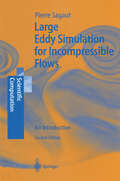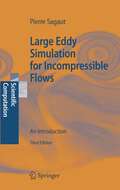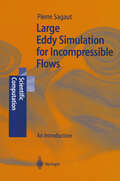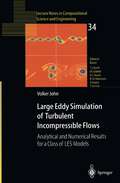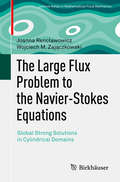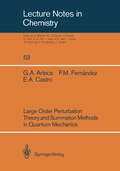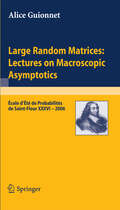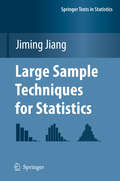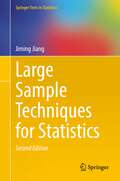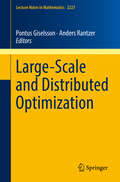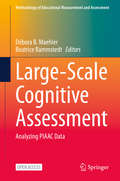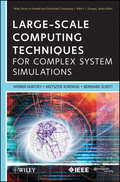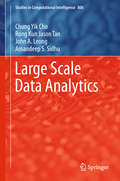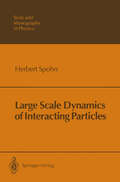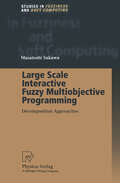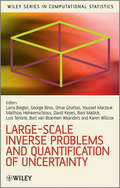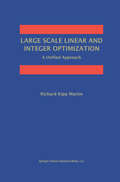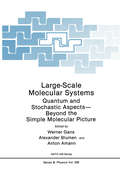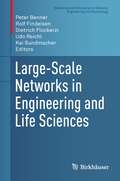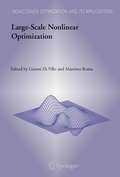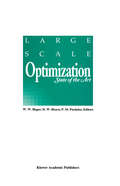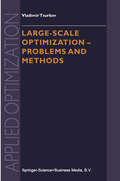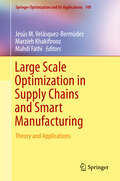- Table View
- List View
Large Eddy Simulation for Incompressible Flows: An Introduction (Scientific Computation)
by P. SagautFirst concise textbook on Large-Eddy Simulation, a very important method in scientific computing and engineering From the foreword to the third edition written by Charles Meneveau: "... this meticulously assembled and significantly enlarged description of the many aspects of LES will be a most welcome addition to the bookshelves of scientists and engineers in fluid mechanics, LES practitioners, and students of turbulence in general."
Large Eddy Simulation for Incompressible Flows: An Introduction (Scientific Computation)
by P. SagautFirst concise textbook on Large-Eddy Simulation, a very important method in scientific computing and engineering From the foreword to the third edition written by Charles Meneveau: "... this meticulously assembled and significantly enlarged description of the many aspects of LES will be a most welcome addition to the bookshelves of scientists and engineers in fluid mechanics, LES practitioners, and students of turbulence in general."
Large Eddy Simulation for Incompressible Flows: An Introduction (Scientific Computation)
by Pierre SagautFirst concise textbook on Large-Eddy Simulation, a very important method in scientific computing and engineering From the foreword to the third edition written by Charles Meneveau: "... this meticulously assembled and significantly enlarged description of the many aspects of LES will be a most welcome addition to the bookshelves of scientists and engineers in fluid mechanics, LES practitioners, and students of turbulence in general."
Large Eddy Simulation of Turbulent Incompressible Flows: Analytical and Numerical Results for a Class of LES Models (Lecture Notes in Computational Science and Engineering #34)
by Volker JohnLarge eddy simulation (LES) seeks to simulate the large structures of a turbulent flow. This is the first monograph which considers LES from a mathematical point of view. It concentrates on LES models for which mathematical and numerical analysis is already available and on related LES models. Most of the available analysis is given in detail, the implementation of the LES models into a finite element code is described, the efficient solution of the discrete systems is discussed and numerical studies with the considered LES models are presented.
The Large Flux Problem to the Navier-Stokes Equations: Global Strong Solutions in Cylindrical Domains (Advances in Mathematical Fluid Mechanics)
by Joanna Rencławowicz Wojciech M. ZajączkowskiThis monograph considers the motion of incompressible fluids described by the Navier-Stokes equations with large inflow and outflow, and proves the existence of global regular solutions without any restrictions on the magnitude of the initial velocity, the external force, or the flux. To accomplish this, some assumptions are necessary: The flux is close to homogeneous, and the initial velocity and the external force do not change too much along the axis of the cylinder. This is achieved by utilizing a sophisticated method of deriving energy type estimates for weak solutions and global estimates for regular solutions—an approach that is wholly unique within the existing literature on the Navier-Stokes equations. To demonstrate these results, three main steps are followed: first, the existence of weak solutions is shown; next, the conditions guaranteeing the regularity of weak solutions are presented; and, lastly, global regular solutions are proven. This volume is ideal for mathematicians whose work involves the Navier-Stokes equations, and, more broadly, researchers studying fluid mechanics.
Large Order Perturbation Theory and Summation Methods in Quantum Mechanics (Lecture Notes in Chemistry #53)
by Gustavo A. Arteca Francisco M. Fernandez Eduardo A. CastroThe book provides a general, broad approach to aspects of perturbation theory. The aim has been to cover all topics of interest, from construction, analysis, and summation of perturbation series to applications. Emphasis is placed on simple methods, as well as clear, intuitive ideas stemming from the physics of systems of interest.
Large Random Matrices: École d'Été de Probabilités de Saint-Flour XXXVI – 2006 (Lecture Notes in Mathematics #1957)
by Alice GuionnetRandom matrix theory has developed in the last few years, in connection with various fields of mathematics and physics. These notes emphasize the relation with the problem of enumerating complicated graphs, and the related large deviations questions. Such questions are also closely related with the asymptotic distribution of matrices, which is naturally defined in the context of free probability and operator algebra.The material of this volume is based on a series of nine lectures given at the Saint-Flour Probability Summer School 2006. Lectures were also given by Maury Bramson and Steffen Lauritzen.
Large Sample Techniques for Statistics (Springer Texts in Statistics)
by Jiming JiangIn a way, the world is made up of approximations, and surely there is no exception in the world of statistics. In fact, approximations, especially large sample approximations, are very important parts of both theoretical and - plied statistics.TheGaussiandistribution,alsoknownasthe normaldistri- tion,is merelyonesuchexample,dueto thewell-knowncentrallimittheorem. Large-sample techniques provide solutions to many practical problems; they simplify our solutions to di?cult, sometimes intractable problems; they j- tify our solutions; and they guide us to directions of improvements. On the other hand, just because large-sample approximations are used everywhere, and every day, it does not guarantee that they are used properly, and, when the techniques are misused, there may be serious consequences. 2 Example 1 (Asymptotic? distribution). Likelihood ratio test (LRT) is one of the fundamental techniques in statistics. It is well known that, in the 2 “standard” situation, the asymptotic null distribution of the LRT is?,with the degreesoffreedomequaltothe di?erencebetweenthedimensions,de?ned as the numbers of free parameters, of the two nested models being compared (e.g., Rice 1995, pp. 310). This might lead to a wrong impression that the 2 asymptotic (null) distribution of the LRT is always? . A similar mistake 2 might take place when dealing with Pearson’s? -test—the asymptotic distri- 2 2 bution of Pearson’s? -test is not always? (e.g., Moore 1978).
Large Sample Techniques for Statistics (Springer Texts in Statistics)
by Jiming JiangThis book offers a comprehensive guide to large sample techniques in statistics. With a focus on developing analytical skills and understanding motivation, Large Sample Techniques for Statistics begins with fundamental techniques, and connects theory and applications in engaging ways.The first five chapters review some of the basic techniques, such as the fundamental epsilon-delta arguments, Taylor expansion, different types of convergence, and inequalities. The next five chapters discuss limit theorems in specific situations of observational data. Each of the first ten chapters contains at least one section of case study. The last six chapters are devoted to special areas of applications. This new edition introduces a final chapter dedicated to random matrix theory, as well as expanded treatment of inequalities and mixed effects models. The book's case studies and applications-oriented chapters demonstrate how to use methods developed from large sample theory in real world situations. The book is supplemented by a large number of exercises, giving readers opportunity to practice what they have learned. Appendices provide context for matrix algebra and mathematical statistics. The Second Edition seeks to address new challenges in data science.This text is intended for a wide audience, ranging from senior undergraduate students to researchers with doctorates. A first course in mathematical statistics and a course in calculus are prerequisites..
Large-Scale and Distributed Optimization (Lecture Notes in Mathematics #2227)
by Pontus Giselsson Anders RantzerThis book presents tools and methods for large-scale and distributed optimization. Since many methods in "Big Data" fields rely on solving large-scale optimization problems, often in distributed fashion, this topic has over the last decade emerged to become very important. As well as specific coverage of this active research field, the book serves as a powerful source of information for practitioners as well as theoreticians.Large-Scale and Distributed Optimization is a unique combination of contributions from leading experts in the field, who were speakers at the LCCC Focus Period on Large-Scale and Distributed Optimization, held in Lund, 14th–16th June 2017. A source of information and innovative ideas for current and future research, this book will appeal to researchers, academics, and students who are interested in large-scale optimization.
Large-Scale Cognitive Assessment: Analyzing PIAAC Data (Methodology of Educational Measurement and Assessment)
by Débora B. Maehler Beatrice RammstedtThis open access methodological book summarises existing analysing techniques using data from PIAAC, a study initiated by the OECD that assesses key cognitive and occupational skills of the adult population in more than 40 countries. The approximately 65 PIAAC datasets that has been published worldwide to date has been widely received and used by an interdisciplinary research community. Due to the complex structure of the data, analyses with PIAAC datasets are very challenging. To ensure the quality and significance of these data analyses, it is necessary to instruct users in the correct handling of the data. This methodological book provides a standardised approach to successfully implementing these data analyses. It contains examples of and tools for the analysis of the PIAAC data using different statistical approaches and software, and it offers perspectives from various disciplines. The contributing authors have hands-on experience of using PIAAC data, and/or they have conducted data analysis workshops with these data.
Large-Scale Computing Techniques for Complex System Simulations (Wiley Series on Parallel and Distributed Computing #80)
by Werner Dubitzky Krzysztof Kurowski Bernard SchottComplex systems modeling and simulation approaches are being adopted in a growing number of sectors, including finance, economics, biology, astronomy, and many more. Technologies ranging from distributed computing to specialized hardware are explored and developed to address the computational requirements arising in complex systems simulations. The aim of this book is to present a representative overview of contemporary large-scale computing technologies in the context of complex systems simulations applications. The intention is to identify new research directions in this field and to provide a communications platform facilitating an exchange of concepts, ideas and needs between the scientists and technologist and complex system modelers. On the application side, the book focuses on modeling and simulation of natural and man-made complex systems. On the computing technology side, emphasis is placed on the distributed computing approaches, but supercomputing and other novel technologies are also considered.
Large-Scale Computing Techniques for Complex System Simulations (Wiley Series on Parallel and Distributed Computing #80)
by Werner Dubitzky Krzysztof Kurowski Bernard SchottComplex systems modeling and simulation approaches are being adopted in a growing number of sectors, including finance, economics, biology, astronomy, and many more. Technologies ranging from distributed computing to specialized hardware are explored and developed to address the computational requirements arising in complex systems simulations. The aim of this book is to present a representative overview of contemporary large-scale computing technologies in the context of complex systems simulations applications. The intention is to identify new research directions in this field and to provide a communications platform facilitating an exchange of concepts, ideas and needs between the scientists and technologist and complex system modelers. On the application side, the book focuses on modeling and simulation of natural and man-made complex systems. On the computing technology side, emphasis is placed on the distributed computing approaches, but supercomputing and other novel technologies are also considered.
Large Scale Data Analytics (Studies in Computational Intelligence #806)
by Chung Yik Cho Rong Kun Tan John A. Leong Amandeep S. SidhuThis book presents a language integrated query framework for big data. The continuous, rapid growth of data information to volumes of up to terabytes (1,024 gigabytes) or petabytes (1,048,576 gigabytes) means that the need for a system to manage and query information from large scale data sources is becoming more urgent. Currently available frameworks and methodologies are limited in terms of efficiency and querying compatibility between data sources due to the differences in information storage structures. For this research, the authors designed and programmed a framework based on the fundamentals of language integrated query to query existing data sources without the process of data restructuring. A web portal for the framework was also built to enable users to query protein data from the Protein Data Bank (PDB) and implement it on Microsoft Azure, a cloud computing environment known for its reliability, vast computing resources and cost-effectiveness.
Large Scale Dynamics of Interacting Particles (Theoretical and Mathematical Physics)
by Herbert SpohnThis book deals with one of the fundamental problems of nonequilibrium statistical mechanics: the explanation of large-scale dynamics (evolution differential equations) from models of a very large number of interacting particles. This book addresses both researchers and students. Much of the material presented has never been published in book-form before.
Large Scale Interactive Fuzzy Multiobjective Programming: Decomposition Approaches (Studies in Fuzziness and Soft Computing #48)
by Masatoshi SakawaSimultaneous considerations of multiobjectiveness, fuzziness and block angular structures involved in the real-world decision making problems lead us to the new field of interactive multiobjective optimization for large scale programming problems under fuzziness. The aim of this book is to introduce the latest advances in the new field of interactive multiobjective optimization for large scale programming problems under fuzziness on the basis of the author's continuing research. Special stress is placed on interactive decision making aspects of fuzzy multiobjective optimization for human-centered systems in most realistic situations when dealing with fuzziness. The book is intended for graduate students, researchers and practitioners in the fields of operations research, industrial engineering, management science and computer science.
Large-Scale Inverse Problems and Quantification of Uncertainty (Wiley Series in Computational Statistics #712)
by Lorenz Biegler George Biros Omar Ghattas Matthias Heinkenschloss David Keyes Bani Mallick Youssef Marzouk Luis Tenorio Bart van Bloemen Waanders Karen WillcoxThis book focuses on computational methods for large-scale statistical inverse problems and provides an introduction to statistical Bayesian and frequentist methodologies. Recent research advances for approximation methods are discussed, along with Kalman filtering methods and optimization-based approaches to solving inverse problems. The aim is to cross-fertilize the perspectives of researchers in the areas of data assimilation, statistics, large-scale optimization, applied and computational mathematics, high performance computing, and cutting-edge applications. The solution to large-scale inverse problems critically depends on methods to reduce computational cost. Recent research approaches tackle this challenge in a variety of different ways. Many of the computational frameworks highlighted in this book build upon state-of-the-art methods for simulation of the forward problem, such as, fast Partial Differential Equation (PDE) solvers, reduced-order models and emulators of the forward problem, stochastic spectral approximations, and ensemble-based approximations, as well as exploiting the machinery for large-scale deterministic optimization through adjoint and other sensitivity analysis methods. Key Features: Brings together the perspectives of researchers in areas of inverse problems and data assimilation. Assesses the current state-of-the-art and identify needs and opportunities for future research. Focuses on the computational methods used to analyze and simulate inverse problems. Written by leading experts of inverse problems and uncertainty quantification. Graduate students and researchers working in statistics, mathematics and engineering will benefit from this book.
Large-Scale Inverse Problems and Quantification of Uncertainty (Wiley Series in Computational Statistics #708)
by Lorenz Biegler Youssef Marzouk David Keyes George Biros Omar Ghattas Matthias Heinkenschloss Bani Mallick Luis Tenorio Bart Van Bloemen Waanders Karen WillcoxThis book focuses on computational methods for large-scale statistical inverse problems and provides an introduction to statistical Bayesian and frequentist methodologies. Recent research advances for approximation methods are discussed, along with Kalman filtering methods and optimization-based approaches to solving inverse problems. The aim is to cross-fertilize the perspectives of researchers in the areas of data assimilation, statistics, large-scale optimization, applied and computational mathematics, high performance computing, and cutting-edge applications. The solution to large-scale inverse problems critically depends on methods to reduce computational cost. Recent research approaches tackle this challenge in a variety of different ways. Many of the computational frameworks highlighted in this book build upon state-of-the-art methods for simulation of the forward problem, such as, fast Partial Differential Equation (PDE) solvers, reduced-order models and emulators of the forward problem, stochastic spectral approximations, and ensemble-based approximations, as well as exploiting the machinery for large-scale deterministic optimization through adjoint and other sensitivity analysis methods. Key Features: Brings together the perspectives of researchers in areas of inverse problems and data assimilation. Assesses the current state-of-the-art and identify needs and opportunities for future research. Focuses on the computational methods used to analyze and simulate inverse problems. Written by leading experts of inverse problems and uncertainty quantification. Graduate students and researchers working in statistics, mathematics and engineering will benefit from this book.
Large Scale Linear and Integer Optimization: A Unified Approach
by Richard Kipp MartinThis is a textbook about linear and integer linear optimization. There is a growing need in industries such as airline, trucking, and financial engineering to solve very large linear and integer linear optimization problems. Building these models requires uniquely trained individuals. Not only must they have a thorough understanding of the theory behind mathematical programming, they must have substantial knowledge of how to solve very large models in today's computing environment. The major goal of the book is to develop the theory of linear and integer linear optimization in a unified manner and then demonstrate how to use this theory in a modern computing environment to solve very large real world problems. After presenting introductory material in Part I, Part II of this book is de voted to the theory of linear and integer linear optimization. This theory is developed using two simple, but unifying ideas: projection and inverse projec tion. Through projection we take a system of linear inequalities and replace some of the variables with additional linear inequalities. Inverse projection, the dual of this process, involves replacing linear inequalities with additional variables. Fundamental results such as weak and strong duality, theorems of the alternative, complementary slackness, sensitivity analysis, finite basis the orems, etc. are all explained using projection or inverse projection. Indeed, a unique feature of this book is that these fundamental results are developed and explained before the simplex and interior point algorithms are presented.
Large-Scale Molecular Systems: Quantum and Stochastic Aspects—Beyond the Simple Molecular Picture (Nato Science Series B: #258)
by Werner Gans Alexander Blumen Anton AmannThis NATO Advanced Study Institute centered on large-scale molecular systems: Quantum mechanics, although providing a general framework for the description of matter, is not easily applicable to many concrete systems of interest; classical statistical methods, on the other hand, allow only a partial picture of the behaviour of large systems. The aim of the ASI was to present both aspects of the subject matter and to foster interaction between the scientists working in these important areas of theoretical physics and theoretical chemistry. The quantum-mechanical part was mostly based on the operator-algebraic formulation of quantum mechanics and comprised quantum statistics of infinite systems with special em phasis on macroscopic observables, equilibrium conditions, irreversibility on the one hand, symmetry breaking for molecules in the radiation field and macroscopic quantum phenomena in the theory of superconductivity (BCS-theory) on the other hand. In addition, phase-space methods for many-body systems were also presented. Statistical physics was the main topic in the other lectures of the School; much emphasis was put on the statistical features of macros copic ("large") systems, the lectures dealt with mass and energy transport im polymers, in gels and in microemulsions, with aggregation and growth phenomena, with relaxation in complex, correlated systems, with conduction and optical properties of polymers, and with the means of describing disordered systems, above all fractals and related hierarchical models.
Large-Scale Networks in Engineering and Life Sciences (Modeling and Simulation in Science, Engineering and Technology)
by Peter Benner Rolf Findeisen Dietrich Flockerzi Udo Reichl Kai SundmacherThis edited volume provides insights into and tools for the modeling, analysis, optimization, and control of large-scale networks in the life sciences and in engineering. Large-scale systems are often the result of networked interactions between a large number of subsystems, and their analysis and control are becoming increasingly important. The chapters of this book present the basic concepts and theoretical foundations of network theory and discuss its applications in different scientific areas such as biochemical reactions, chemical production processes, systems biology, electrical circuits, and mobile agents. The aim is to identify common concepts, to understand the underlying mathematical ideas, and to inspire discussions across the borders of the various disciplines. The book originates from the interdisciplinary summer school “Large Scale Networks in Engineering and Life Sciences” hosted by the International Max Planck Research School Magdeburg, September 26-30, 2011, and will therefore be of interest to mathematicians, engineers, physicists, biologists, chemists, and anyone involved in the network sciences. In particular, due to their introductory nature the chapters can serve individually or as a whole as the basis of graduate courses and seminars, future summer schools, or as reference material for practitioners in the network sciences.
Large-Scale Nonlinear Optimization (Nonconvex Optimization and Its Applications #83)
by Gianni Pillo Massimo RomaThis book reviews and discusses recent advances in the development of methods and algorithms for nonlinear optimization and its applications, focusing on the large-dimensional case, the current forefront of much research. Individual chapters, contributed by eminent authorities, provide an up-to-date overview of the field from different and complementary standpoints, including theoretical analysis, algorithmic development, implementation issues and applications.
Large Scale Optimization: State of the Art
by William W. Hager D. W. Hearn Panos M. PardalosOn February 15-17, 1993, a conference on Large Scale Optimization, hosted by the Center for Applied Optimization, was held at the University of Florida. The con ference was supported by the National Science Foundation, the U. S. Army Research Office, and the University of Florida, with endorsements from SIAM, MPS, ORSA and IMACS. Forty one invited speakers presented papers on mathematical program ming and optimal control topics with an emphasis on algorithm development, real world applications and numerical results. Participants from Canada, Japan, Sweden, The Netherlands, Germany, Belgium, Greece, and Denmark gave the meeting an important international component. At tendees also included representatives from IBM, American Airlines, US Air, United Parcel Serice, AT & T Bell Labs, Thinking Machines, Army High Performance Com puting Research Center, and Argonne National Laboratory. In addition, the NSF sponsored attendance of thirteen graduate students from universities in the United States and abroad. Accurate modeling of scientific problems often leads to the formulation of large scale optimization problems involving thousands of continuous and/or discrete vari ables. Large scale optimization has seen a dramatic increase in activities in the past decade. This has been a natural consequence of new algorithmic developments and of the increased power of computers. For example, decomposition ideas proposed by G. Dantzig and P. Wolfe in the 1960's, are now implement able in distributed process ing systems, and today many optimization codes have been implemented on parallel machines.
Large-scale Optimization: Problems and Methods (Applied Optimization #51)
by Vladimir TsurkovDecomposition methods aim to reduce large-scale problems to simpler problems. This monograph presents selected aspects of the dimension-reduction problem. Exact and approximate aggregations of multidimensional systems are developed and from a known model of input-output balance, aggregation methods are categorized. The issues of loss of accuracy, recovery of original variables (disaggregation), and compatibility conditions are analyzed in detail. The method of iterative aggregation in large-scale problems is studied. For fixed weights, successively simpler aggregated problems are solved and the convergence of their solution to that of the original problem is analyzed. An introduction to block integer programming is considered. Duality theory, which is widely used in continuous block programming, does not work for the integer problem. A survey of alternative methods is presented and special attention is given to combined methods of decomposition. Block problems in which the coupling variables do not enter the binding constraints are studied. These models are worthwhile because they permit a decomposition with respect to primal and dual variables by two-level algorithms instead of three-level algorithms. Audience: This book is addressed to specialists in operations research, optimization, and optimal control.
Large Scale Optimization in Supply Chains and Smart Manufacturing: Theory and Applications (Springer Optimization and Its Applications #149)
by Jesús M. Velásquez-Bermúdez Marzieh Khakifirooz Mahdi FathiIn this book, theory of large scale optimization is introduced with case studies of real-world problems and applications of structured mathematical modeling. The large scale optimization methods are represented by various theories such as Benders’ decomposition, logic-based Benders’ decomposition, Lagrangian relaxation, Dantzig –Wolfe decomposition, multi-tree decomposition, Van Roy’ cross decomposition and parallel decomposition for mathematical programs such as mixed integer nonlinear programming and stochastic programming. Case studies of large scale optimization in supply chain management, smart manufacturing, and Industry 4.0 are investigated with efficient implementation for real-time solutions. The features of case studies cover a wide range of fields including the Internet of things, advanced transportation systems, energy management, supply chain networks, service systems, operations management, risk management, and financial and sales management. Instructors, graduate students, researchers, and practitioners, would benefit from this book finding the applicability of large scale optimization in asynchronous parallel optimization, real-time distributed network, and optimizing the knowledge-based expert system for convex and non-convex problems.
